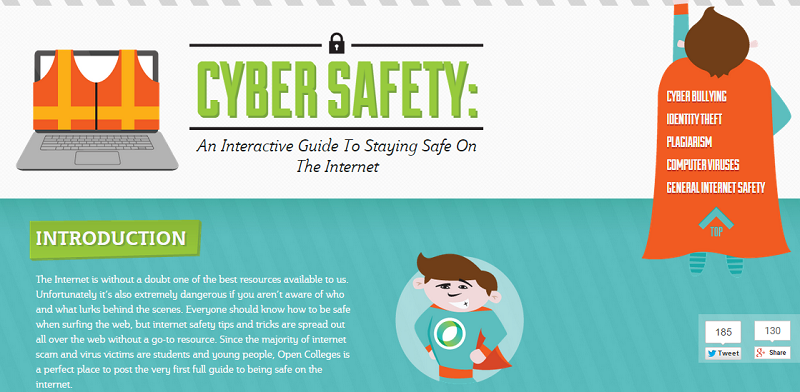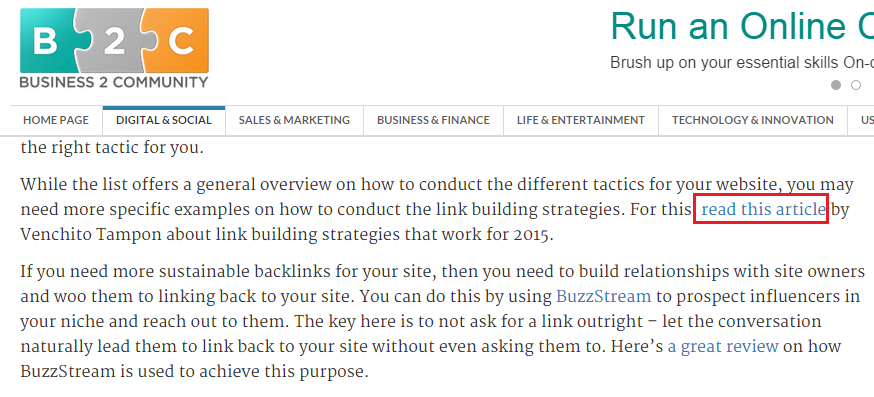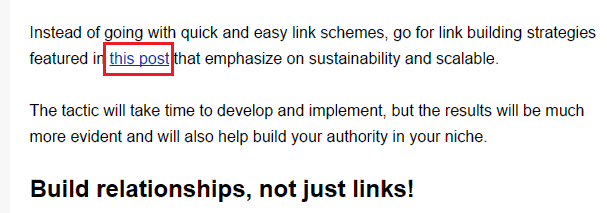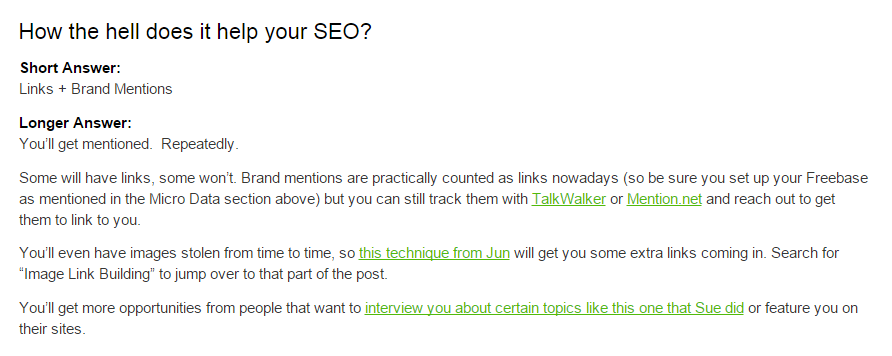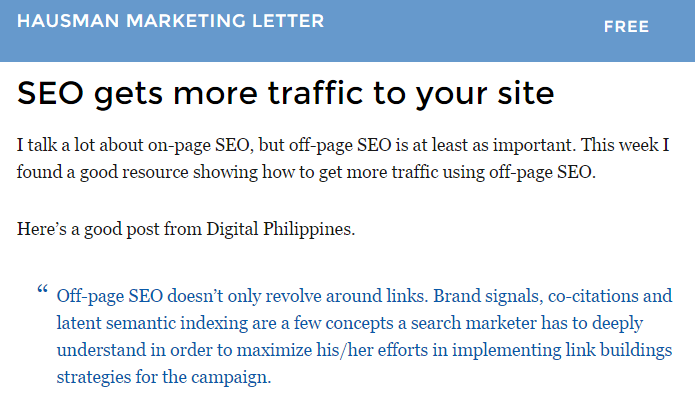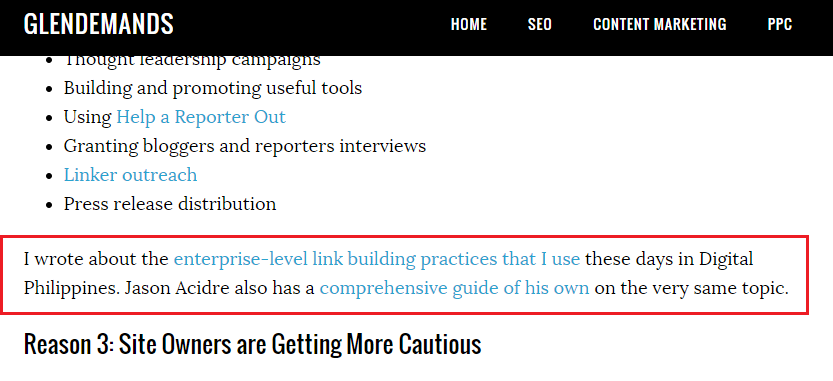by Venchito Tampon Jr | Last Updated on October 24, 2021
A contextual link is a powerful type of backlink that is placed within the content of a page, earned through linkbait approach (utility of the content and blogger relationships) or voluntarily acquiring it by providing external content piece on a specific blog/site (e.g. guest post with a link pointing to your content/page).
Contextual links pass more ranking ability or link value than those links placed in the lower portion of the page. This gives rise to the importance of building editorial/contextual links to increase the authority and importance of your content, page or domain.
On a more detailed level, Bill Slawski shared other elements that might be considered by Google in context scores/identifiers (term used to create a score for each backlink) – which would make your contextual link building more powerful when primarily look at.
These elements include:
- The number of links to the document
- The importance of the documents linking to the document
- The freshness of the documents linking to the document
- Other known ranking factors
If there aren’t many of the said context identifiers in a document, the ranking value for that link that might be passed to another page will be ignored (this patent refers to as a hypertext relevance signal).
In other words, even if there are hundreds of backlinks pointing to your page but they’re not as important and authoritative in the eyes of Google, then they’re nearly useless for your target content/site.
Before getting straight to actionable tips on how to build high quality contextual links to your website and give you a few case studies to support those methods, let’s first understand some elements of contextual link building.
Elements of Contextual Link Building
Trust
Trust is still one of the important components of link building since what constitutes a prospect linker to give you a link will mostly depend on two things:
- How your brand’s content piece helps their audience, if they own a blog.
- How well they know your expertise as an industry author/content publisher (which can be implied in the quality of the content).
Trust building is like planting a seed. It takes a considerable amount of time for your target audience (linkers) to give a vote of confidence on your content/brand.
Authority
Authority gives boost to the ranking potential of a page/domain, thus, helps accelerate the overall influence of the brand over its targeted space/sub-segment (if there are many sub-niches in one industry).
Authority is essential in link building, in a sense, that a content piece must be linked to by relevant and authoritative pages in order for search engines to perceive it as an authoritative page.
SEObytheSea is a good example of an authoritative domain in the search marketing industry that earned its reputation because of a few trusted websites that contextually link to its blog pages (e.g. Moz).
It’s the trust and authority of the linking page that matters these days.
Content Asset
A content that is considered as an asset of the company/site would definitely be given attention to by its content creator, particularly on the side of its content promotion phase.
If you consider every content piece that you publish as a business asset, the confidence and efforts you’ll exert in promoting the page is much higher than simply thinking of it as an accomplishment check to your editorial calendar (blogging frequency).
In the exact link acquisition phase, it would be easy for you to write an outreach pitch to a particular group of linker audience since you are confident enough that outreach responses would certainly convert to editorial links, based on how helpful it is to a particular blogger/webmaster.
The question is, “Could it be considered to add as a useful resource to an existing relevant content?”
Effective Strategies to Earn Contextual Links
Build evergreen and linkable content assets
Evergreen content is a content piece that constantly attracts attention, traffic and links and stays “fresh” for readers for the longest period of time (almost) because of its untimely information and data.
Linkable content is a content asset targeted to a specific linkable audience that aims to solve a certain problem and/or to fill a missing gap/information in the industry.
Combining evergreen and linkability principles to a content asset would certainly make it a powerful linkbait piece that will constantly attract natural backlinks even several months or years after it has been published.
So how can you build an evergreen and linkable content asset? Here are some actionable ways that you can follow.
Search for a linkable topic in your industry
Linkability of a topic is not based on the search volume of a niche keyword or phrase, but on the amount of existing resource pages and blog posts that can potentially link to your content asset.
How can you find a verified linkable topic?
Think of the audience that you want to target for your content. It may not be your target customers but a specific group of content consumers. If the linkable audience is part of your core group of customers, then there’s a high chance to build links to your content and at the same time, generate leads and sales from it.
Now, here are verified linkable audiences that you can target for your content piece (from Citation Labs):
- Teachers
- Caregivers
- Parents
- Senior citizens
- Veterans
- Health conditions sufferers
- Job Seekers
- The Unemployed Workers in the Non-Profit sector (people curing societal ills such as homelessness, poverty, abuse)
- Members of any underserved communities (immigrants, people with disabilities, etc.)
- Local community
- Students
- Families of Substance Abusers
If your company is selling blinds and curtains, then one of the topics of that are mostly discuss about is sun protection.
In order to determine if that topic is linkable, you need to find at least 50 available links pages or curated content on that particular topic (50+ pages in the search results).
Do a Google search for consumers + topic.
Example search queries:
“for parents” inurl:links.html “sun safety”
“for parents” inurl:links.html “sun protection”
If you still don’t have any potential linkable topics, here are some of the methods that you can use:
- Search for “site:.gov or site:.edu + industry head keyword”. Scan the results pages or even click on each page listed in the search results. See what topics are being discussed. Given that you are getting content inspirations from non-commercial pages (government and educational domains), the likelihood of searching for a relevant and linkable topic is higher.
- Visit the product or service features of your company (especially those ones that are different from your competitors). Understand how your brand can help serve your customers (mission driven). In the above example, curtains helps protect the family at home from sunlight – which is the basic function or purpose of a curtain.
- Grab the URL of a popular guide/resource in your industry and plug it into the Google Keyword Planner’s landing page feature. You’ll uncover keyword opportunities that are somehow linkable in nature.
Now that you have a linkable topic, you can then proceed to the actual content creation.
Create a linkable topic
There are two important considerations when creating a linkable content: information and format
Information
I believe with what Brian Dean emphasized in his latest post at Backlinko that choosing the right topic or information is 90% of the game.
A content piece with unique and useful information for relevant search terms attracts positive usage signals, signaling search engines that the page deserves to rank higher in search results.
There are many methodologies to find useful topic that will fit into your next content asset, a few of these content ideation strategies that worked for me are:
- Using open data resources to grab credible online information related to your online sphere (Data Gov, Google Public Data and Freebase).
- Inviting content creators and industry influencers to participate in creating the content by asking them simple niche-specific questions (28+ Failed Link Building Experiments).
- Asking customers for stories not necessarily pertaining to your brand (products/services) but a topic that will accumulate interest across your community (i.e. struggles of pet lovers).
You can check out this post on how to develop your content assets like a pro.
Format
Format makes information readable to visitors, making it easy for them to consume the content.
A good content format helps bloggers and potential linkers to scan the page and instantly decide whether or not it’s worthy of contextual links on their websites.
For linkable content assets, here are some examples of formats that can concise your information:
- Calculator
- Guide
- Infographic Preventing _____
- Tutorial
- Online Tools
- Cost Estimator
- Guide For Parents of _____*
- Guide For Educators of _____*
- Guide For Caretakers of ____*
- Safety Checklist for _____
- Guide to Legal Rights for _____
- Online Locator
A few more formatting tips you can consider:
- Use bold and italic text features strategically, only when you want to emphasize important concepts, so visitors are able to scan (especially skimmers) through it and pick out the essential information at a glance.
- Make external links open in a new window so readers don’t lose your site whey click on them.
- Use Bucket Brigade (a classic tip from Brian Dean) to break information and get users stay on the page for a longer time (e.g. words like Here’s the deal:, now:, what’s the bottom line?; you might be wondering:; this is crazy).
Once you have published your content piece, it’s time to get promoted it in front of your listed potential linkers.
Outreach to verified linkable audience
Here are some outreach tips to dramatically increase your conversion rate:
- Write your outreach email specific to the target linker’s page (including Name and Blog’s title in your messages would add more responses to your campaign). This is pretty basic but I still see a lot of link request emails failed in this part.
- Short and straightforward emails convert better than longer and detailed ones.
- Let your potential linkers where and how you found them (this removes the stranger barrier in the conversation).
- Don’t instruct to link to your page/content. Since they are linkers, they know what to do after you’ve shared your content.
Evergreen and linkable content pieces can consistently help your brand earn contextual backlinks that guarantee increase in page’s authority and might improve search ranking potential eventually.
Regularly connect with content creators
Relationship building is still one of my favorite link building tactics, since this strategy doesn’t depend on the current status of the blog and how many keywords it ranked in SERPs but more on the level of confidence and trust the potential linker has put into the content creator.
Since the day I started to focus on link building as my main theme of this blog, I’ve built almost a hundred strong relationships where most of them helped me build my business and get me acquired voluntarily-given links coming from different sub-niches of this industry (blogging, affiliate marketing, conversion rate optimization, etc..).
To give you an example, here are three bloggers that I’ve built strong connections with, to whom I owe some of the editorial links I earned from other blogs:
- Rohit Palit. I pitched him an email last year, asking if I could become a regular contributor for his blog, Techtage, which after months of contributing posts resulted to a good friendship.
- Christopher Benitez. He asked me to participate in a blog interview (just this year), where I was glad to answer questions pertaining to link building topics. This gave an instant connection between me and Chris.
- Dennis Seymour. He reached out to me a few months ago, then eventually turned out to be one of my fellow SEO bloggers.
The relationship I had with Rohit resulted to some good link opportunities – contextual links from some of his content contributions on other blogs, not Techtage.
Below are some screenshots of contextual links I earned from Ahrefs, a link building blog where Rohit became a regular author.


Chris, on other hand gave me some links from Business2Community and Internet Marketing 101.
Dennis built recurring links to my blog (2 editorial links from Leapfrog – here and here).
A few tips on how to earn links from relationship building (with content creators):
- Target low and mid-tier bloggers when trying to increase your influence size. There are higher chances to receive positive responses from mid-tier expert authors than those highly influential ones.
- Involve yourself in social groups (Facebook and Google+ Communities) that are relevant to your industry. Become an active contributor by answering questions where you have knowledge to.
- Direct your conversations from email to social platforms (like Skype and Facebook) to regularly engage with bloggers in real time.
- Become the first linker to their blogs. Create a friends section/page on your website and list them down as your co-bloggers in your space.
There are almost no effort exerted to relationship building in order to earn links (aside from the time you put into conversations).
Imagine if you have 20 industry friends and they happened to link to any of your posts (at least 2 every 6 months). That’s 80 links every year (6 contextual backlinks each month) with no costs involved in the link acquisition process.
Take advantage of local meetups
Local meetups are small gatherings that regularly happen across a city, with program schedules designed to learn from industry experts/speakers and to network with colleagues in the blogging sphere.
One of the misconceptions of some marketers today is that local meetups doesn’t add any business value nor does it bring direct customers. In short, they say that attending in a local meetup is a waste of time.
I believe that one of the important benefits of local meetups (and relationship building in general) is the set of intangible benefits they provide to a certain person. These intangible benefits include client referrals, speaking opportunities, advertising chance (mostly free) and other things that would impact the business revenue and to the website the brand is operating.
Two years ago, I attended my first MORCon (Master Online Rankings Conference), one of the premier internet marketing conferences here in the Philippines.
This gave me a chance to network with the best brains in the search marketing industry including Jason Acidre and Glen Dimaandal (quick note: they are now the top officers of the organization).
Besides networking, it helped my link building blog to get some contextual links straight from the speakers themselves (Sean Si, Vic Abrugar and Roel Manarang).
Here are the screenshots of those links.
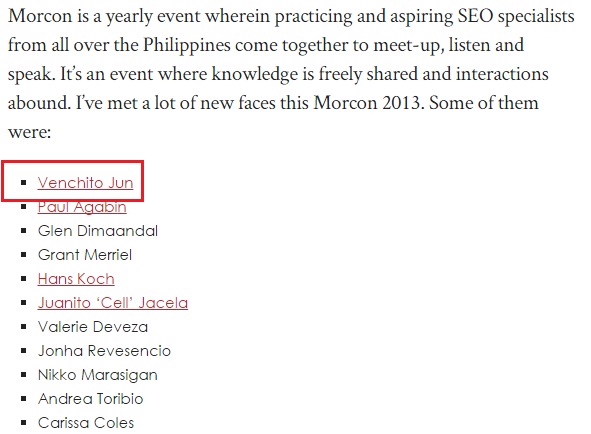
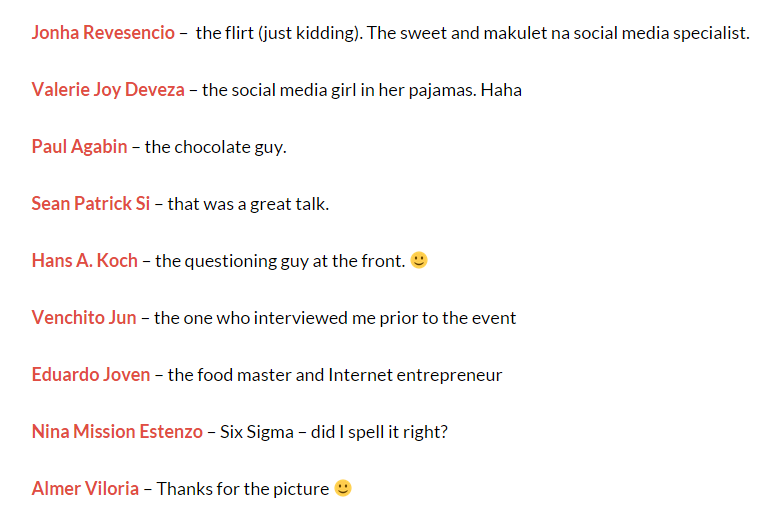
Push out strong context with high linkability intent
One of the primary reasons why most content pieces didn’t get much traction on the web – earning links from other niche-specific blogs is that they lack in uniqueness and strong opinion.
Expertise is best seen in content when the content creator justifies a strong argument and/or concludes one statement that makes as his/her main point in the page.
One of good example of how you can earn links through exemplifying a strong statement is this link from Hausman Marketing Letter.
As you can see in the image below, the author included the introduction of my post in his article, which I believe became the strong unique proposition of my content.
When writing highly linkable content:
- Cite external links or sources in your post where you got credible data from. No need to include them if they are information solely produced by your brand.
- Think twice or thrice before releasing a statement/argument. It can either give you a break in the industry or break your reputation literally.
- Provide unexpected hooks in your content that haven’t been published in other blogs. This gives you a high potential of getting cited because of your actionable points.
Invite industry experts to write content for your blog
One of the linkbait approaches that will still last effective even years from now is inviting industry authors to contribute a post for your blog. One reason is that this link building idea isn’t scalable and couldn’t be done in a regular basis unless you’ve got a long list of industry authors, whom you can reach out to for guest content contribution.
There are many ways to entice someone to create content for your brand, but here are some that you can try:
- Pitch an industry blogger with a proposition to expose him to a large audience (readers) and social (followers), in case, you’re a big brand that happened to have a new blog in your website.
- Initiate linking to his/her blog from any of your posts (whether old and new). Tell him that you linked out to his/her content via email or social. There’s an instant connection when you converse with him and had him respond to your messages.
- Provide free access to your brand’s premium products/services in exchange for his content.
Below is an example of a contextual link I earned from Glen Demands blog, which linked to his guest post on my blog.
This link building approach can help you earn links given that the guest author will cite his guest content in his personal blog and/or in his posts contributed to other blogs.
Offer to translate your content or accept an approval to do so
Translating in your content proves to be a very effective strategy to build contextual backlinks that will certainly pass ranking value and referred traffic to the linked page/content.
Since the translated content is published on another blog where the audience hasn’t been approached by the original author, the likelihood of absorbing new readers and social followers from the blog where content is translated would be higher.
A few considerations to keep in mind:
- Receiving pitches to translate your content is better than pushing your content out to potential linkers (mostly non-English bloggers). You might have a low chance to turn a conversation into one link primarily because of the language barrier.
- When approving a proposal to translate your content, make sure to check out their blog one in a while to see if they’re really linking out to your content/page (as what they have said in your conversation). You can also setup alerts for mentions (linked or unlinked) to ensure that the niche blogger is linking to your piece. You can use Monitor Backlinks for this approach.
- Invest in building content assets on one main topic (for example in my case, link building) to constantly remind your audience about your expertise, since this is the main reason international bloggers would want to translate your content and be published on their own blogs.
Here is a screenshot of an email that I received few weeks ago. It is a pitch asking for approval to translate my content in Arabic language.
Imagine if you published at least expertly made piece every week and three bloggers are willing to translate them to other languages and then, published it on their own blogs. That’s 12 contextual links every month with no effort and cost at all.
Accept interview opportunities regardless of the blog size
Interviews are content evidences of the expertise of a certain brand or author. Through answering industry questions, potential readers would have a better understanding on what the brand is and how capable the author is when producing articles for his blog.
I’ve been receiving a lot of interview opportunities these days and had been answering all of them as much as I can.
Here are a few things that I managed to do in the past few years with regards to interview linking opportunities:
- Accept interview opportunities regardless of the domain authority of a blog. What you want to build here is the momentum of earning interview links.
- Focus your answers on one topic. Though surely you will base them on the questions, but if they will ask you what topic you’re comfortable of discussing about, always try to focus on one (in my case, it’s link building).
- As soon as the momentum starts to build, you can answer questions from other sub-niches of your industry (in my case, it is affiliate marketing, blogging, conversation rate optimization and startup).
- Try to get at least one contextual link pointing to your page/content and one link for your brand.
- Never abuse linking to all of your content (this will only cause bad impression to your future potential interviewers).
Examples of recent interviews:
Leverage connections with industry curators
Curation is a content marketing approach that gains its popularity for the past several years, for the reason that it gives mutual benefits to the author of the page/content being linked to it and to the curator himself. The cited author gets a link while the curator has provided an article for his blog.
Engaging with curators in your industry could actually help your brand expand its audience reach, as you can be seen and visited by readers from other blogs, which gives another opportunity to earn another set of links.
Ways to properly engage niche curators:
- Leave sensible comments in their blog posts. Try to get their attention by answering their last question (their call to actions at the end of their posts) and/or cite an experience/example based on the topic of their post.
- Simply share your content without pushing them out to link to your content/page.
My recent links from roundup posts:
- 55 of the Best Link Building & SEO Posts of 2015 (So Far)
- SEOlympics: Top Marketing Blogs of the Philippines
- 246 Content Marketing Resources
If you are looking for a link building agency to partner with you, then don’t hesitate to contact us today.
The Author
Venchito Tampon Jr
Venchito Tampon is a Filipino Motivational Speaker, Corporate Trainer, and a Leadership Speaker in the Philippines. He is the CEO and Co-Founder of SharpRocket, a link building agency. With a decade of experience, Venchito has a proven track record of leading hundreds of successful SEO (link builidng) campaigns across competitive industries like finance, B2B, legal, and SaaS. His expert advice as a link building expert has been featured in renowned publications such as Semrush, Ahrefs, Huffington Post and Forbes. He is also an international SEO spoken and has delivered talks in SEO Zraz, Asia Pacific Affiliate Summit in Singapore, and Search Marketing Summit in Sydney, Australia. Check out his other businesses, Hills & Valleys Cafe, Blend N Sips and Saas Pursuit.
How our LINK BUILDING AGENCY builds 250 links/mo consistently using Predictable Link Building Methodology™…
- Using a SIMPLE and PROVEN system
- Using a SCALABLE strategy
- No private blog networks
- No creepy outreach emails

